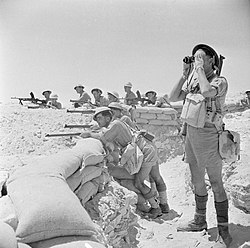
Back حملة شمال إفريقيا Arabic Şimali Afrika kampaniyası Azerbaijani قوزئی آفریقا کامپانیاسی AZB Северноафриканска кампания Bulgarian Campanya del nord d'Àfrica Catalan Druhá světová válka v Africe Czech Ymgyrch Gogledd Affrica Welsh Felttoget i Nordafrika Danish Afrikafeldzug German Εκστρατεία της Βόρειας Αφρικής Greek
| North African campaign | |||||||||
|---|---|---|---|---|---|---|---|---|---|
| Part of Mediterranean and Middle East theatre of World War II | |||||||||
 British troops on the defensive posture during the First Battle of El Alamein, July 1942. | |||||||||
| |||||||||
| Belligerents | |||||||||
|
|
| ||||||||
| Commanders and leaders | |||||||||
| Casualties and losses | |||||||||
| |||||||||
The North African campaign of World War II took place in North Africa from 10 June 1940 to 13 May 1943, fought between the Allies and the Axis Powers. It included campaigns in the Libyan and Egyptian deserts (Western Desert campaign, Desert War), in Morocco and Algeria (Operation Torch), and in Tunisia (Tunisia campaign). The Allied war effort was dominated by the British Commonwealth and exiles from German-occupied Europe. The United States officially entered the war in December 1941 and began direct military assistance in North Africa on 11 May 1942.
Fighting in North Africa started with the Italian declaration of war on 10 June 1940. On 14 June, the British 11th Hussars and part of the 1st Royal Tank Regiment, (1st RTR) crossed the border from Egypt into Libya and captured Fort Capuzzo. This was followed by an Italian counter-offensive into Egypt and the capture of Sidi Barrani in September. The British recaptured Sidi Barrani in December during Operation Compass. The Italian 10th Army was destroyed and the German Afrika Korps was dispatched to North Africa in February 1941 in Operation Sonnenblume to reinforce the Italians and prevent an Axis defeat.
Battles for control of Libya and Egypt followed, with advances and retreats until the Second Battle of El Alamein in October 1942 when the Eighth Army (Lieutenant-General Bernard Montgomery) defeated the German–Italian Panzerarmee Afrika and forced its remnants into Tunisia. After Operation Torch, the Anglo-American landings in North-West Africa in November 1942 and fighting against Vichy France forces (which then changed sides), the Allies trapped about 250,000 German and Italian personnel in northern Tunisia, forcing their surrender in May 1943.
Information gleaned via British Ultra code-breaking was important in the Allied victory in North Africa. The Italian campaign followed, culminating in the downfall of the Fascist government in Italy and the elimination of Germany's main European ally. German and Italian forces committed atrocities against prisoners of war and Jewish, Berber and Arab populations.
- ^ Higgins, Jenny (2007). "Royal Artillery". Newfoundland Heritage Web Site.
- ^ Self-governance from 1942
- ^ Carell 1960, p. 597.
- ^ Zabecki 2007, North Africa.
- ^ Cartier 1975, p. 40.
- ^ Playfair et al. 2004c, p. 460. United States losses from 12 November 1942.
- ^ Atkinson 2004, p. 536.
- ^ Istat 1957, p. [page needed].
- ^ Baxter 1996, p. 38.
- ^ Rochat 2005, p. 446.
- ^ Carell 1960, p. 596.
- ^ Barclay, Mediterranean Operations
- ^ Porch 2004, p. 415.
Cite error: There are <ref group=nb> tags on this page, but the references will not show without a {{reflist|group=nb}} template (see the help page).